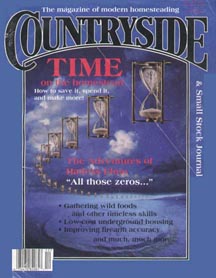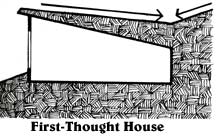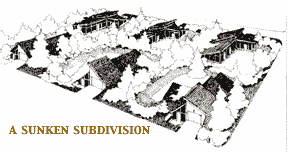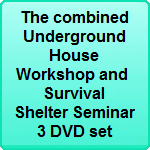|
|
 This special feature is reprinted from Countryside, A small stock
journal:The magazine of modern homesteading This special feature is reprinted from Countryside, A small stock
journal:The magazine of modern homesteading
Unique, affordable shelter you can provide for yourself
Building
underground with Mike Oehler’s PSP system
By J.D. Belanger, Countryside founder and editor
The biggest investment most people have is their home. A mortgage, or rent, is a major item in most
budgets. Many Americans who can’t scrape together a down payment on real estate, or get a mortgage loan,
feel locked out of The Good Life, and the American Dream. And according to some sources, thousands of
people, even in America, have no homes at all.
Most people regard these as inevitable facts of life. Since there’s little they can do about them, they
might as well ignore them.
A few, however, are proactive. They think outside the box, and they have a fighting attitude. They consider
huge, luxurious and expensive homes to be irrelevant to human needs, and wasteful of space, materials, and
money. The cost of interest on a 20- or 30-year mortgage is especially galling to them.
These housing pioneers have included Ken Kern, whose "Owner-Built Home" started many people on the road to
mortgage-free housing in the 1970s. Rob Roy’s "Mortgage Free," as well as his books, videos and workshops on
low-cost cordwood construction, have led the way out of the morass of overbuild, overpriced and consequently
overfinanced housing.
Buckminster Fuller’s geodesic dome enjoyed great popularity among owner-builders in the 1970s, and log
construction has become so common most log homes are now built by commercial enterprises, not
do-it-yourselfers. Other individuals and groups have been promoting building with straw bales, cob (a
mixture of clay and straw), adobe, and houses that range, literally, from under the ground to the
treetops.
One of the people who has broken new ground (literally and figuratively) is Mike Oehler, author of "The $50
& Up Underground House Book." His innovative and ingenious construction methods and design techniques have
been in use for more than 20 years, but few people today are even aware of them.
One reason might be because his methods are too easy, too "primitive," and maybe too inexpensive for most
modern tastes.
On the other hand, these qualities are exactly what some people are looking for… and what could become
extremely valuable in certain situations.
When planning this special feature on "Wilderness Survival," "Countryside" considered using the old "Boy
Scout" and "Air Force Survival Manual" advice on emergency shelter. Frankly, we couldn’t envision readers of
this magazine needing emergency shelter of any kind unless they became lost in the wilderness.
Temporary and emergency shelters used after hurricanes and earthquakes are more likely to be Red Cross tents
rather than something made from branches, or even tarps.
Mike Oehler has a different view. He thinks people will leave the cities in droves after a catastrophe,
when population centers no longer function and are uninhabitable. They would seek food and shelter in the
countryside.
If they encounter Mike Oehler or anyone like him, they’ll be handed an ax, a shovel, a roll of
polyethylene, and directions for building an underground shelter with the PSP system.
This building method is almost as fast, almost as easy, and almost as inexpensive as a Boy Scout hut with
the same area. But with a little more work, time and money, you can build an actual home with the same
method. Mike Oehler has lived in one himself for more than 20 years.
Oh, by the way – this system can also be used to build root cellars and bomb and tornado shelters.
This is something worth knowing about.
It’s safe to assume that most people have never considered living underground. Therefore they have never
looked into the possibilities and know nothing about the concept.
However, it’s equally safe to assume that of those radical enough to not fit into that majority, most have
heard only about concrete constructions that are relatively complex, expensive, and… well,
basement-like.
Mike Oehler’s PSP system, incorporating his unique design innovations, is a totally different concept. In
its way it is both as simple and as amazingly ingenious as a paper clip.
Living underground
Underground homes, according to Mike, are not dark, dank, airless spaces,
with artificial lighting… or even skylights. On the contrary, the properly designed and constructed U
house provides pleasant surroundings, a better view (more on that later), and is most aesthetically
pleasing, inside and out. It is weatherproof, soundproof, relatively fireproof, and requires less
maintenance. It is warm in winter, cool in summer, has superior flooring, and the pipes never freeze. It
has no foundation, uses less building material, requires less labor, and is ecologically sound. It can be
concealed if you choose, defended if need be, and you pay less tax on it. It can be built by anyone, in a
very short time, for hundreds, not tens of thousands of dollars.
Now are you interested in living underground?
If we have your attention, now we can tell you that the key component of the Oehler PSP system is
polyethylene sheeting.
That, along with the "$50 & Up" price tag, is probably a psychological turn-off for those accustomed to
thinking of even manufactured housing costing many thousands of dollars. Who would want to live in a $50
plastic house! Let’s set that objection to rest first, by taking a quick look at the construction
method, and why it makes so much sense.
PSP stands for post/shoring/Polyethylene. These structures are, basically, pole building, built
underground. The low cost projections assume the posts and shoring will come from the building site, or
nearby.
The space is excavated, posts are sunk, boards (shoring) placed against the posts between the posts and
the earthen wall, polyethylene behind that, and the space is backfilled.
The same basic method is used for the roof. Girders are placed on the posts and secured, beams are placed
over the girders, boards go over the beams, followed by roofing felt or tar paper, poly, and earth.
Insulation can be added to the roof to provide the same R-value with less soil (and weight).
Many other details are added to this basic description in "The $50 & Up Underground House Book." The basic
method, however, is all you would need to construct a secure emergency shelter, quickly and cheaply. It
will be far more comfortable than the sod houses or rough log cabins of the pioneers, and its durability
can’t begin to compare with that of a tent or similar shelter.
If the poly still bothers you, consider these facts:
The very word plastic has a negative connotation for most homesteaders and environmentalists. We can use
plastic sheeting for cheap greenhouses, but we know it won’t last more than a couple of months: definitely
not what we would choose for building a home, however temporary.
At the same time, poly is looked down upon because we’re told that in landfills, it will persist for
perhaps a hundred years! It won’t degrade: it will just sit there.
Turn that negative into a positive. If polyethylene, protected from sunlight, will last a hundred years
underground in a landfill, why wouldn’t it last that long when sandwiched between boards and earth in an
underground house?
This kind of brilliant breakthrough thinking is demonstrated in many ways in "The $50 & Up Underground
House Book." Another example is how the use of treated wood for posts is eliminated.
Fence posts and barn poles, sunk into the soil, get wet. Normally, wet wood rots. The industrial complex
answer to this is to treat such wood with chemical preservatives (including, in the past, some that are
now banned for being carcinogenic. But even those still in use are questionable.)
Anyone who has removed rotting fence posts has probably noticed that, in most soils, the area of decay is
just below ground level, where soil microbiological activity is greatest. Often a post can be almost
completely rotted out at this level, while the wood several feet deeper in the ground is still solid. So
it’s possible that a post, buried two feet or more into the ground, in an excavation already as much as
six feet or more in the ground, will last a very long time.
But Oehler doesn’t take any chances, with either rot, or chemical preservatives.
He makes use of the old-time observation that charred wood doesn’t rot. He chars the bottom two feet or
so, of the posts simply by roasting them over a campfire. If any finishing touches are necessary, he uses
a propane torch.
Then for additional insurance, he wraps the post bottom in several plastic garbage bags secured with duct
tape.
There is, obviously, much more to say about PSP construction methods, but that’s putting the cart before
the house, especially if you aren’t convinced that subterranean housing is a reasonable alternative. What
will convince you are the design possibilities. What’s more, before you start to build, you need a
plan.
Design
The PSP construction process is simple and easily understood. But the concept of living
under the ground is extremely alien to most people who haven’t been exposed to Mike Oehler’s design
concepts. In addition, proper design is the single most important key to the success of an underground
dwelling, in terms of light, ventilation, and most importantly, drainage.
So it’s not surprising that Mike spends most of his time and effort, in his book as well as videos, on
design.
Conventional thinking (if that can be applied to something as radical as U housing) most often involves
digging a hole into a hillside and plopping a structure there. A bank of windows faces downhill, while the
uphill side is a solid blank wall. More often than not, if the house is on a south slope, the roof is
pitched back into the hill, so drainage from the roof runs into drainage from the hillside. Leaks are
almost inevitable. There is little or no air flow, the back of the house is dark and damp, and the view is
limited.
Mike calls this the first-thought design. His thinking has taken him far beyond that.

The five approved methods of design
In his videos he stresses designs with views – and light
and ventilation – in all four directions, and he urges viewers to try it themselves (with accompanying
worksheets). Although some of the ideas are revolutionary, he simply calls them the Five Approved Methods
of Design.
They are: the uphill patio; the off-set room; clerestories; the Royer foyer; and gables.
The uphill patio
The uphill patio is as useful as it is clever. It is basically a terraced
garden area, with its bottom at any desired height from the floor of the house, and its top blending into
the adjacent ground level. It not only solves problems of drainage and lateral thrust (the pressure of the
earth on buried walls), but it can function as an emergency exit or a second entrance. It can also serve
as a built-in greenhouse.
Naturally, it admits light and air, even from the uphill side of the house which would otherwise be a dark
blank wall. This not only reduces kerosene or electric bills but results in more balanced lighting.
The view is up to the garden design interests and abilities of the owner, of course. Japanese courtyard
gardens, which are world-renowned works of art, are offered as an example of the possibilities.
And finally, the uphill patio offers a controlled view. It’s determined by the depth of the patio and the
resultant trajectory of sight. No matter what anyone builds nearby, you won’t have to look at it if you
don’t want to. (If the neighbor builds a 20-story high-rise one foot from your property line, put a
greenhouse covering on the patio.) And no one can see into it (or your home) unless they’re standing right
on top of it.
The offset room
The basic U house design is a square or rectangular room. The simple expedient
of adding a second room, and offsetting it to protrude into the uphill patio, provides the opportunity to
install a section of windows which face an entirely different direction. This offers even more advantages
of views, light, and ventilation. Elevating the offset room results in even more design possibilities.
The Royer foyer
The Royer foyer is a design invention which allows us to have a good view down a
hill without rechanneling the flow of drainage or interrupting the purity of design of a shed roof. The
Royer foyer sneaks into the hillside rather than protruding from it. It makes possible a downhill view
from windows that are all but concealed from neighbors.
The foyer (named after the helper friend who came up with the idea) is a pie-shaped excavation away from
the house on the side wall (not the downhill wall) of a downhill corner. It has many advantages and
attributes, all discussed and illustrated in the book.
Clerestories and gables
Clerestories and gables are nothing new, but they can be valuable
contributions to underground housing. As might be expected, however, there are details to consider when
incorporating them into an underground PSP house… where the three primary demands are drainage, drainage,
and drainage. Details are provided in the book.
Also included are discussions of earthen floors, built-in root cellars, earth coolers, a barbecue window
and bachelor bar, plumbing and wiring considerations, engineering rules of thumb, scrounging materials…
and everything else you’ll need to know to build your own pleasant, comfortable and affordable underground
home.
Construction of an emergency shelter
You really need the book, and perhaps the videos, to get a
good grasp of the construction method and, more importantly, design considerations. But many readers who
don’t consider themselves candidates for building an underground house – or even a root cellar or tornado
shelter – might appreciate knowing how it’s done, just in case. Mike Oehler covers this aspect in his
latest book, "The Hippie’s Guide to Y2K" (see review in 83/3:110). He calls it the Pit House. It’s as
simple as this:
Dig a hole. Cover it with logs. Cover the logs and exposed sides with polyethylene. Put four to six inches
of earth on the poly.
He does suggest a few tricks to make the job easier and the shelter better. For example, use the earth
thrown out of the hole as part of the structure, so you don’t have to dig as deep. You want the roof
sloping, not flat. On a slope, put most of the soil on the uphill side, forming a V with the pointed side
uphill. This will divert surface water around the shelter, keeping it drier. Reading both books will give
you many other ideas.
Conclusion
The PSP method of underground construction – and Mike Oehler – provide a wonderful
opportunity for Countryside to transition into the new millennium. Here’s why:
Mike Oehler became involved with underground housing in the hippie heydays of the 1970s. In that regard,
some people will consider it history, as passé as geodesic domes made from junked auto hoods.
But, as we hope the accompanying article makes clear, the advantages of U housing are both numerous and
impressive. There is no reason why the thousands of Countrysiders who say they can’t afford conventional
housing, even mobile homes, can’t build their own underground PSP homes. What’s more, the many thousands
of others who are paying interest on mortgages that double (and more) the cost of their already overpriced
conventional housing could reduce their housing investment and eliminate the interest cost entirely. In
many cases this would also eliminate the need for an outside job, allowing more people to become full-time
homesteaders.
And it goes much further. It extends into the future.
A glimpse of the future?
Some readers will recall that in several articles on our vision of the
21st century, when the general populace will live lives that very closely resemble what we now call
homesteading, the houses were underground, in park-like settings.
Mike Oehler anticipated this more than 20 years ago by including the drawing on the previous page in "The
$50 & Up Underground House Book," with these comments:
Is there an American with a sense of beauty who doesn’t hate the sight of the subdivisions which have
defiled our landscape?
Yet here is where underground housing offers one if its greatest potentials. By putting our subdivisions
underground we can have neighborhoods of unequaled aesthetic appeal. Walking down the street of an
underground subdivision would be like taking a walk in the park, or in the country. The stroller would see
beautifully landscaped mounds with only an occasional door or window peeking out.
Subterranean subdivisions would offer the ultimate in privacy and view. It would be possible to design so
that no one house would have a view of another. Landscaped mounds of earth separating the sunken patios of
the houses would not only ensure visual privacy but would be sound barriers as well.
And there is the added benefit to the home owner of a doubling of his yard space since the roof becomes
additional garden or lawn.
This is what the subdivisions of the future will be like.
Be sure to watch future issues of
Countryside for in-depth articles on actual, lived-in underground homes, and on other forward thinkers
like Mike Oehler, as well as on their many projects that can, should, and we believe will, forge a better
world and a better life in the years ahead.

|
|

 This special feature is reprinted from Countryside, A small stock
journal:The magazine of modern homesteading
This special feature is reprinted from Countryside, A small stock
journal:The magazine of modern homesteading












